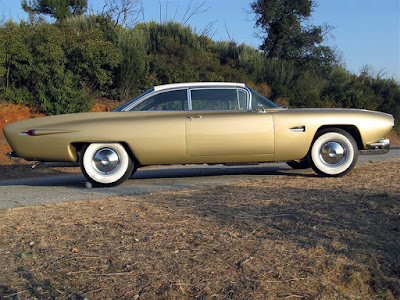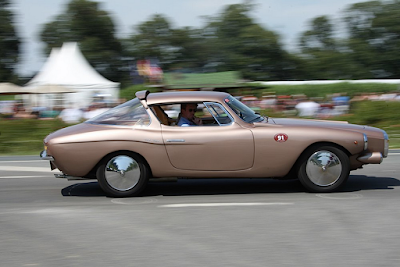Rare ONES Volkswagen
is a German's automotive brand that is very well known in the world
since the 1937 and is the original brand of the Wolfsburg-based
multi-national corporation, besides that they also oversees several
other car brands such as Audi, Bentley Motors, Bugatti Automobiles,
Automobili Lamborghini, SEAT, Škoda Auto, Scania and even Porsche. So it
is not surprising that the German's company has a variety of production
versions of car models.
 |
| The rarely seen of the 1965 Karmann-Ghia Concept designed by Giorgetto Giugiaro of Ghia as one of the design study models to
be submitted to Volkswagen as a replacement model for the Volkswagen
Karmann Ghia. (Picture from: MyCarQuest) |
During
their long business times, we get to know several iconic car models
with the Volkswagen brand, such as the VW Beetle, VW T1 (Kombi), VW
Golf, VW Passat and others. Besides producing car models independently,
the German auto manufacturer also ever been involved several third
parties, especially in the development of special car models.
 |
| The Volkswagen Karmann-Ghia was designed by Luigi Serge of Ghia and manufactured by Karmann ranging of the 1955 to 1974. (Picture from: Jalopnik) |
And
one of the famous collaboration result car models of Volkswagen with
third parties is the VW Karmann-Ghia. This is a sports car (available in
coupe and convertible 2+2 form) built on the chassis and mechanics of
the Volkswagen Beetle, it was designed by Luigi Serge and manufactured
by Karmann ranging of the 1955 to 1974.
 |
| The rarely seen of the 1965 Karmann-Ghia Concept while sat on display at the 2019 Amelia Island Concours d'Elegance. (Picture from: ConceptCarz) |
As
we know, Volkswagen is a conservative company when it comes to dealing
with major changes to its models. That is why they are often so
reluctant to make a style change. But things were different when they
approved the production of the VW Karmann-Ghia, at least they were
willing to accept a style change into looked more fresher and sporty in
the 1950s, even though in technical terms nothing had actually changed
at all.
 |
| The 1965 Karmann-Ghia Concept is appeared with a lean, sleek and clean bodywork, so made it looks very modern and very striking especially for 1965. (Picture from: Jalopnik) |
As qouted of the Jalopnik, Karmann, a compatriot company built the Karmann-Ghia for Volkswagen in collaboration with Carrozzeria Ghia, an Italian design house, whose often would design updated versions of their Karmann-Ghia in hopes Volkswagen would sign off, even though they never did and the original Ghia kept on as before. But Karmann never stopped trying to get Volkswagen excited about something new, which is why this particular car exist.
Until
one day in the 1965, Karmann prepared and built three design study models to
be submitted to Volkswagen as a replacement model for the Volkswagen
Karmann Ghia and one of them named Karmann-Ghia Concept. As qouted of Conceptcarz, the car designed by Giorgetto Giugiaro while he worked for Ghia. The car built on a slightly wider version chassis than
what it's used on the normal Karmann-Ghia. And it's appeared with a
lean, sleek and clean bodywork, so made it looks very modern and very
striking especially for 1965. Besides that the model has a certain form
of precision which later became popular in the 1980s.
 |
| The 1965 Karmann-Ghia Concept is based on the Type 1 platform and is appeared with different sides both in the left-right (some nice brightwork trim, and both a Ghia shield-badge and the KARMANN badge at the rear, it’s pretty elegant and fancy). (Picture from: Flickr) |
So
it could be said, the model should be born in the next fews decades
ahead not in the 1965. It's also a pretty dramatic departure from the
look and feel of not just the original Karmann Ghia, but almost any
other models that Volkswagen was building at the time. As you can see,
some of the curves and round shapes that were so dominating in the
original model are now gone, replaced smooth planes with undercuts and
angled cutaways that give the car an agile, lith and modern boxy look.
This
study design model is also a very interesting demonstration about how
flexible VW’s standard platform chassis was for carrying radically
different body designs. In our unibody-dominated modern world, this sort
of thing is much harder to pull off, but back in the day, VW was
basically showed us, they can build pretty much bodies as many they
wanted only on one chassis.
 |
| The 1965 Karmann-Ghia Concept is based on the Type 1 platform and is appeared with different sides both in the left-right (the finger-hole for the door handle mimics of the shark's gills-like engine cooling air vents). (Picture from: Flickr) |
There
are several unusual features installed on the study design model, such
the turn signal indicators on the dashboard in the form of a lavish,
decadent two little green arrows to let you know which way you’re
turning, was next to impossible for decades. Then to fill the
generously-sized engine bay of this one-off model is a standard VW Type I
1,300 cc 40 hp engine by using an offset air cleaner. While this is a real car, on a
real chassis, and even drivable, it’s still just a design study, so you
find some interesting details, like these engine air intake vents
stickers.
Something else also only can find on this design study model, turn out the left and right sides are not the same. That's intended in order to evaluate two different design ideas for the door handles and side air cooling vents. On the the driver's side with some nice brightwork trim, and both a Ghia shield-badge and the KARMANN badge at the rear, it’s pretty elegant and fancy. The door handle is a minimal button and finger cut-out, very clean and slick.
Meanwhile, on the passenger side, we find a totally different and unique approach, especially the way of the finger-hole for the door handle mimics of the shark's gills-like engine cooling air vents. This is a bit bolder and sportier than the other side. Which side do you like better?
Write your choice in the comments column below this article. If only we have the time machines and go back to the past, so that we can help and give the input to Karmann in choosing the best design in the 1965.😀 *** [EKA | FROM VARIOUS SOURCES | JALOPNIK | WIKIPEDIA | MYCARQUEST | CONCEPTCARZ ]
Note: This blog can be accessed via your smart phone.









































